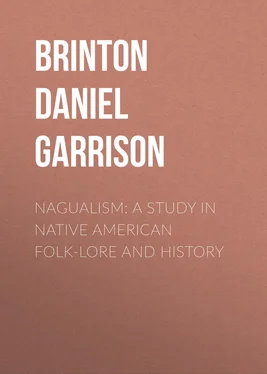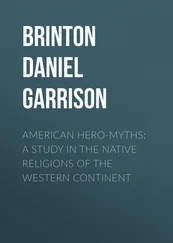Daniel Brinton - Nagualism - A Study in Native American Folk-lore and History
Здесь есть возможность читать онлайн «Daniel Brinton - Nagualism - A Study in Native American Folk-lore and History» — ознакомительный отрывок электронной книги совершенно бесплатно, а после прочтения отрывка купить полную версию. В некоторых случаях можно слушать аудио, скачать через торрент в формате fb2 и присутствует краткое содержание. ISBN: , Жанр: foreign_antique, foreign_prose, на английском языке. Описание произведения, (предисловие) а так же отзывы посетителей доступны на портале библиотеки ЛибКат.
- Название:Nagualism: A Study in Native American Folk-lore and History
- Автор:
- Жанр:
- Год:неизвестен
- ISBN:http://www.gutenberg.org/ebooks/26426
- Рейтинг книги:4 / 5. Голосов: 1
-
Избранное:Добавить в избранное
- Отзывы:
-
Ваша оценка:
- 80
- 1
- 2
- 3
- 4
- 5
Nagualism: A Study in Native American Folk-lore and History: краткое содержание, описание и аннотация
Предлагаем к чтению аннотацию, описание, краткое содержание или предисловие (зависит от того, что написал сам автор книги «Nagualism: A Study in Native American Folk-lore and History»). Если вы не нашли необходимую информацию о книге — напишите в комментариях, мы постараемся отыскать её.
Nagualism: A Study in Native American Folk-lore and History — читать онлайн ознакомительный отрывок
Ниже представлен текст книги, разбитый по страницам. Система сохранения места последней прочитанной страницы, позволяет с удобством читать онлайн бесплатно книгу «Nagualism: A Study in Native American Folk-lore and History», без необходимости каждый раз заново искать на чём Вы остановились. Поставьте закладку, и сможете в любой момент перейти на страницу, на которой закончили чтение.
Интервал:
Закладка:
5.Intoxication of some kind was an essential part of many of these secret rites. It was regarded as a method of throwing the individual out of himself and into relation with the supernal powers. What the old historian, Father Joseph de Acosta, tells us about the clairvoyants and telepaths of the aborigines might well stand for a description of their modern representatives:
“Some of these sorcerers take any shape they choose, and fly through the air with wonderful rapidity and for long distances. They will tell what is taking place in remote localities long before the news could possibly arrive. The Spaniards have known them to report mutinies, battles, revolts and deaths, occurring two hundred or three hundred leagues distant, on the very day they took place, or the day after.
“To practice this art the sorcerers, usually old women, shut themselves in a house, and intoxicate themselves to the degree of losing their reason. The next day they are ready to reply to questions.” 17 17 Acosta, De la Historia Moral de Indias , Lib. v, cap. 26.
Plants possessing similar powers to excite vivid visions and distort the imagination, and, therefore, employed in the magical rites, were the thiuimeezque , in Michoacan, and the chacuaco , in lower California. 18 18 Of the thiuimeezque Hernandez writes: “Aiunt radicis cortice unius unciæ pondere tuso, atque devorato, multa ante oculos observare phantasmata, multiplices imagines ac monstrificas rerum figuras, detegique furem, si quidpiam rei familiaris subreptum sit.” Hist. Plant. Nov. Hispan. , Tom. iii, p. 272. The chacuaco and its effects are described by Father Venegas in his History of California , etc.
6.In spite of all effort, the various classes of wonder-workers continued to thrive in Mexico. We find in a book of sermons published by the Jesuit Father, Ignacio de Paredes, in the Nahuatl language, in 1757, that he strenuously warns his hearers against invoking, consulting, or calling upon “the devilish spell-binders, the nagualists, and those who conjure with smoke.” 19 19 “In Mictlan Tetlachihuique, in Nanahualtin, in Tlahuipuchtin.” Paredes, Promptuario Manual Mexicano , p. 128 (Mexico, 1757). The tlahuipuchtin , “those who work with smoke,” were probably diviners who foretold the future from the forms taken by smoke in rising in the air. This class of augurs were also found in Peru, where they were called Uirapircos (Balboa, Hist. du Perou , p. 28-30).
They have not yet lost their power; we have evidence enough that many children of a larger growth in that land still listen with respect to the recitals of the mysterious faculties attributed to the nanahualtin . An observant German traveler, Carlos von Gagern, informs us that they are widely believed to be able to cause sicknesses and other ills, which must be counteracted by appropriate exorcisms, among which the reading aloud certain passages of the Bible is deemed to be one of the most potent. 20 20 Von Gagern, Charakteristik der Indianischer Bevölkerung Mexikos , s. 125.
The learned historian, Orozco y Berra, speaks of the powers attributed at the present day to the nahual in Mexico among the lower classes, in these words:
“The nahual is generally an old Indian with red eyes, who knows how to turn himself into a dog, woolly, black and ugly. The female witch can convert herself into a ball of fire; she has the power of flight, and at night will enter the windows and suck the blood of little children. These sorcerers will make little images of rags or of clay, then stick into them the thorn of the maguey and place them in some secret place; you can be sure that the person against whom the conjuration is practiced will feel pain in the part where the thorn is inserted. There still exist among them the medicine-men, who treat the sick by means of strange contortions, call upon the spirits, pronounce magical incantations, blow upon the part where the pain is, and draw forth from the patient thorns, worms, or pieces of stone. They know how to prepare drinks which will bring on sickness, and if the patients are cured by others the convalescents are particular to throw something of their own away, as a lock of hair, or a part of their clothing. Those who possess the evil eye can, by merely looking at children, deprive them of beauty and health, and even cause their death.” 21 21 Historia Antigua de Mexico , Tom. ii, p. 25. Francisco Pimentel, in his thoughtful work, Memoria sobre las Causas que han originado la Situacion Actual de la Raza Indigena de Mexico (Mexico, 1864), recognizes how almost impossible it is to extirpate their faith in this nagualism. “Conservan los agueros y supersticiones de la antigüedad, siendo cosa de fe para ellos, los nahuales ,” etc., p. 200, and comp. p. 145.
7.As I have said, nowhere in the records of purely Mexican, that is, Aztecan, Nagualism do we find the word nagual employed in the sense given in the passage quoted from Herrera, that is as a personal guardian spirit or tutelary genius. These tribes had, indeed, a belief in some such protecting power, and held that it was connected with the day on which each person is born. They called it the tonalli of a person, a word translated to mean that which is peculiar to him, which makes his individuality, his self. The radical from which it is derived is tona , to warm, or to be warm, from which are also derived tonatiuh , the sun. Tonalli , which in composition loses its last syllable, is likewise the word for heat, summer, soul, spirit and day, and also for the share or portion which belongs to one. Thus, to-tonal is spirit or soul in general; no-tonal , my spirit; no-tonal in ipan no-tlacat , “the sign under which I was born,” i. e. , the astrological day-sign. From this came the verb tonalpoa , to count or estimate the signs, that is, to cast the horoscope of a person; and tonalpouhque , the diviners whose business it was to practice this art. 22 22 On these terms consult the extensive Dictionnaire de la Langue Nahuatl , by Rémi Simeon, published at Paris, 1887. It is not impossible that tona is itself a compound root, including the monosyllabic radical na , which is at the basis of nagual .
These tonalpouhque are referred to at length by Father Sahagun. 23 23 Sahagun, Historia de Nueva España , Lib. iv, passim , and Lib. x, cap. 9.
He distinguishes them from the naualli , though it is clear that they corresponded in functions to the nagualistic priests of the southern tribes. From the number and name of the day of birth they forecast the destiny of the child, and stated the power or spiritual influence which should govern its career.
The tonal was by no means an indefeasible possession. It was a sort of independent mascotte . So long as it remained with a person he enjoyed health and prosperity; but it could depart, go astray, become lost; and then sickness and misfortune arrived. This is signified in the Nahuatl language by the verbs tonalcaualtia , to check, stop or suspend the tonal , hence, to shock or frighten one; and tonalitlacoa , to hurt or injure the tonal , hence, to cast a spell on one, to bewitch him.
This explains the real purpose of the conjuring and incantations which were carried on by the native doctor when visiting the sick. It was to recall the tonal , to force or persuade it to return; and, therefore, the ceremony bore the name “the restitution of the tonal ,” and was more than any other deeply imbued with the superstitions of Nagualism. The chief officiant was called the tetonaltiani , “he who concerns himself with the tonal.” On a later page I shall give the formula recited on such an occasion.
Читать дальшеИнтервал:
Закладка:
Похожие книги на «Nagualism: A Study in Native American Folk-lore and History»
Представляем Вашему вниманию похожие книги на «Nagualism: A Study in Native American Folk-lore and History» списком для выбора. Мы отобрали схожую по названию и смыслу литературу в надежде предоставить читателям больше вариантов отыскать новые, интересные, ещё непрочитанные произведения.
Обсуждение, отзывы о книге «Nagualism: A Study in Native American Folk-lore and History» и просто собственные мнения читателей. Оставьте ваши комментарии, напишите, что Вы думаете о произведении, его смысле или главных героях. Укажите что конкретно понравилось, а что нет, и почему Вы так считаете.












